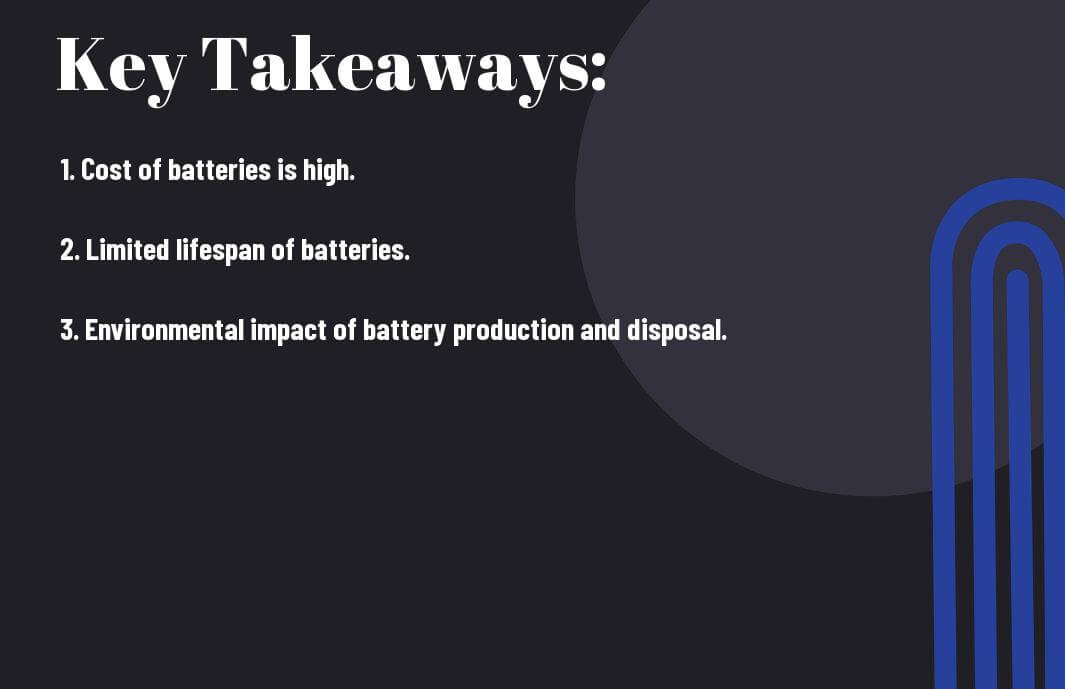It’s intriguing to explore solar energy and its storage possibilities, but have you considered the limitations? In the context of storing solar energy in batteries, there are three key drawbacks you should be aware of. These drawbacks may affect the efficiency and effectiveness of your solar power system. Let’s investigate into these potential challenges and how they impact your renewable energy setup.

Key Takeaways:
- Cost: Storing solar energy in batteries can be expensive due to the high cost of purchasing and maintaining the batteries.
- Efficiency: Energy losses occur during the process of storing and retrieving energy from batteries, resulting in lower overall efficiency compared to direct use of solar energy.
- Lifespan: Batteries have a limited lifespan and deteriorate over time, requiring replacement or maintenance which adds to the overall cost of storing solar energy.

Limited Capacity
A drawback to storing solar energy in batteries is the limited capacity they offer. This limitation can be attributed to various factors related to the physical characteristics of batteries.
Battery Size and Weight Limitations
Limitations in battery size and weight can affect the amount of solar energy that can be stored. Larger batteries tend to have higher storage capacities, but they also take up more space and can be heavier, making them less practical for certain applications. If you’re looking to store a significant amount of solar energy for your home or business, you may find yourself limited by the size and weight constraints of available battery options.
Energy Density Constraints
Density constraints refer to the amount of energy that can be stored in a given volume or weight of a battery. Some battery technologies have lower energy densities, meaning they can store less energy per unit of volume or weight. This can be a limiting factor when considering how much solar energy you can store in a battery system.
Size plays a crucial role in energy density constraints. For example, lithium-ion batteries are known for their high energy density, making them popular choices for storing solar energy. However, even with advancements in battery technology, there are still limits to how much energy can be stored within a certain space or weight limit.
High Upfront Costs
Some Pros And Cons Of Solar Battery Storage include high upfront costs. In the matter of storing solar energy in batteries, the initial investment in battery technology can be significant. You may need to purchase not only the solar panels but also the batteries and a compatible system to store and manage the energy efficiently.
Initial Investment in Battery Technology
Costs associated with purchasing and installing a solar battery storage system can add up quickly. While prices have been decreasing in recent years, the initial investment can still be a significant financial burden. However, it’s vital to consider the long-term savings and benefits of having a solar battery storage system in place.
Ongoing Maintenance and Replacement Expenses
Upfront costs are just the beginning. You also need to consider the ongoing maintenance and replacement expenses associated with solar battery storage. While solar panels are known for their durability and low maintenance requirements, batteries may need more regular upkeep and eventual replacement. This can add to the overall cost of storing solar energy in batteries over time.
Expenses such as monitoring the battery’s performance, replacing faulty cells, or upgrading the system as technology advances can all contribute to the overall cost of maintaining a solar battery storage system. It’s vital to factor in these ongoing expenses when considering whether storing solar energy in batteries is the right choice for your energy needs.
Inefficiencies in Charging and Discharging
Once again, storing solar energy in batteries comes with drawbacks, and one significant issue lies in the inefficiencies during the charging and discharging processes.
Energy Loss during Conversion
Any time you convert energy from one form to another, there will be inevitable losses. When solar energy is converted into electricity to charge a battery, not all of the energy is stored. Similarly, when you draw power from the battery to use electricity, there are further losses during the conversion back to usable energy. These inefficiencies mean that you lose some of the solar energy you worked hard to collect.
Inverter and Converter Inefficiencies
Discharging stored energy from batteries involves the use of inverters and converters to convert the DC power stored in the battery to AC power for use in your home. However, these devices are not 100% efficient, leading to energy losses during the conversion process.
Another issue is that these inverters and converters consume a small amount of power themselves just to operate, further reducing the overall efficiency of the system. The more conversions that occur from DC to AC and vice versa, the more energy is lost in the process.
Battery Degradation over Time
One of the most significant drawbacks to storing solar energy in batteries is the degradation of the batteries over time.
One of the factors contributing to battery degradation is the number of charge and discharge cycles the battery goes through. Over time, the capacity of the battery to store energy diminishes.
Over time, the efficiency of the battery decreases, and you will need to replace the batteries, adding to the overall cost of your solar energy storage system.
Environmental Impact
Resource Extraction for Battery Production
Production of batteries for storing solar energy requires a significant amount of resources. The extraction of raw materials such as lithium, cobalt, and nickel can have detrimental effects on the environment. Mining activities for these materials can lead to deforestation, soil erosion, and water pollution. Additionally, the process of extracting these resources often involves energy-intensive methods, contributing to greenhouse gas emissions and further exacerbating climate change.
Toxic Chemicals and Waste Disposal Concerns
Disposal of batteries used to store solar energy can pose significant environmental challenges. Batteries contain toxic chemicals such as lead, lithium, and cadmium, which can leach into the soil and water if not disposed of properly. Improper disposal of these toxic materials can pollute the surrounding environment, posing risks to human health and wildlife. Recycling technologies for batteries are still developing, and the proper disposal and recycling of used batteries remain a pressing concern.
For instance, improper disposal of lithium-ion batteries can lead to fires in landfills due to their flammable nature. These fires can release harmful toxins into the air and soil, further polluting the environment. As the demand for solar energy storage continues to rise, finding sustainable solutions for the disposal and recycling of batteries will be crucial to mitigating the environmental impact of this technology.

Technological Limitations
Current Battery Technologies’ Inabilities
To begin with, current battery technologies have limitations in terms of energy density, efficiency, and lifespan. While lithium-ion batteries have been the most popular choice for storing solar energy, they have constraints in terms of storing enough energy for longer periods of time. This means that if you have days of little to no sunlight, you may not have enough stored energy to rely on.
Additionally, lithium-ion batteries can degrade over time, losing their ability to hold a charge effectively. This decrease in efficiency can lead to more frequent replacements, adding to the overall cost of storing solar energy. Therefore, current battery technologies may not be the most sustainable or cost-effective solution in the long run.
Research and Development Challenges
Technologies for storing solar energy are still in the early stages of development, and there are several research and development challenges that need to be addressed. Scientists and engineers are working towards creating batteries with higher energy density, longer lifespan, and improved efficiency. However, these advancements take time and require significant investment in research and testing.
This means that while there is great potential for better battery technologies in the future, it may take several years before these advancements become commercially available and affordable for widespread use. Therefore, the current limitations of battery technologies for storing solar energy may not be fully resolved in the near future.
Grid Integration Challenges
Voltage and Frequency Fluctuations
To effectively integrate solar energy into the grid, you need to consider the challenges posed by voltage and frequency fluctuations. When solar energy is stored in batteries, there can be issues related to maintaining a stable voltage and frequency in the grid. Fluctuations in voltage and frequency can lead to power quality issues and impact the overall reliability of the grid.
Grid Stability and Power Quality Issues
To ensure the stability of the grid, it is crucial to address grid integration challenges posed by the storage of solar energy in batteries. Grid stability can be compromised when a large amount of solar energy is injected into the grid at once, causing fluctuations in power flow. This can result in power quality issues such as voltage sags and frequency variations, impacting the performance of electrical devices connected to the grid.
Issues related to grid stability and power quality can be further exacerbated by the intermittent nature of solar energy generation. As solar panels rely on sunlight, energy production can vary throughout the day depending on weather conditions. This variability can make it challenging to maintain grid stability and ensure a consistent power supply to consumers.
To wrap up
As a reminder, storing solar energy in batteries can be a great way to harness and utilize renewable energy. However, there are drawbacks to consider. Firstly, the cost of batteries can be significant, adding to the overall expense of a solar energy system. Additionally, batteries have a limited lifespan and will need to be replaced every few years, again adding to the costs and creating waste. Finally, the environmental impact of manufacturing and disposing of batteries can be a concern, as the process can generate pollution and harm ecosystems.
Q: What are three drawbacks to storing solar energy in batteries?
A: One drawback is the cost associated with purchasing and maintaining the batteries. Another drawback is the limited lifespan of batteries, which may need to be replaced every few years. Additionally, storing energy in batteries can result in energy loss through heat dissipation and inefficiencies in the charging and discharging process.
